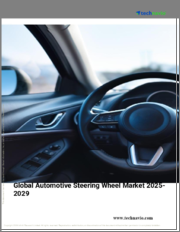
|
시장보고서
상품코드
1670151
자동차용 스티어링 휠 시장 규모, 점유율, 성장 분석 : 소재 유형별, 제품 유형별, 기술별, 스티어링 휠 유형별, 최종 용도차 유형별, 지역별 - 산업 예측(2025-2032년)Automotive Steering Wheel Market Size, Share, and Growth Analysis, By Material Type, By Product Type, By Technology, By Steering Wheel Type, By End Use Vehicle Type, By Region - Industry Forecast 2025-2032 |
||||||
세계의 자동차용 스티어링 휠 시장 규모는 2023년에 252억 달러에 달하며, 예측 기간(2025-2032년)의 CAGR은 6.3%로, 2024년 267억 9,000만 달러에서 2032년에는 436억 7,000만 달러로 성장할 전망입니다.
자동차 스티어링 휠 시장은 자동차 수요의 급증과 스티어링 기술의 발전으로 인해 큰 성장이 예상됩니다. 운전자의 안전과 인체공학적 개선에 대한 관심이 높아짐에 따라 시장 진출기업에게 새로운 길을 열어줄 것으로 예상됩니다. 첨단운전자보조시스템(ADAS)의 통합과 혁신적인 스티어링 휠 디자인에 대한 지속적인 투자가 2032년까지 수요를 더욱 촉진할 것으로 보입니다. 또한 프리미엄 및 고급 차량 기능에 대한 소비자 선호도가 높아지면서 시장 성장 전망은 더욱 높아질 것으로 예상됩니다. 아시아태평양은 이러한 확장을 주도할 가능성이 높습니다. 하지만, 후부착의 복잡성, 첨단 시스템의 높은 비용, 자율주행 자동차의 부상, 엄격한 안전 규제 등의 문제가 예측 기간 중 판매를 저해할 수 있습니다.
목차
서론
- 조사의 목적
- 조사 범위
- 정의
조사 방법
- 정보 조달
- 2차와 1차 데이터 방법
- 시장 규모 예측
- 시장의 전제조건과 제한
개요
- 세계 시장 전망
- 공급과 수요 동향 분석
- 부문별 기회 분석
시장 역학과 전망
- 시장 개요
- 시장 규모
- 시장 역학
- 촉진요인과 기회
- 억제요인과 과제
- Porter의 산업 분석
주요 시장 인사이트
- 주요 성공 요인
- 경쟁의 정도
- 주요 투자 기회
- 시장 에코시스템
- 시장의 매력 지수(2024년)
- PESTEL 분석
- 거시경제 지표
- 밸류체인 분석
- 가격 분석
- 사례 연구
- 고객과 구매 기준 분석
자동차용 스티어링 휠 시장 규모 : 소재 유형별
- 시장 개요
- 플라스틱
- 레더
- 목재
- 금속
자동차용 스티어링 휠 시장 규모 : 제품 유형별
- 시장 개요
- 표준 스티어링 휠
- 퍼포먼스 스티어링 휠
- 조정 가능 스티어링 휠
자동차용 스티어링 휠 시장 규모 : 기술별
- 시장 개요
- 노멀 스티어링 휠
- 컨트롤 내장 스티어링 휠
자동차용 스티어링 휠 시장 규모 : 스티어링 휠 유형별
- 시장 개요
- 기존 스티어링 휠
- 전동 파워스티어링 휠
- 유압식 파워스티어링 휠
자동차용 스티어링 휠 시장 규모 : 최종 용도 차종별
- 시장 개요
- 승용차
- 상용차
- 고급차
자동차용 스티어링 휠 시장 규모
- 북미
- 미국
- 캐나다
- 유럽
- 독일
- 스페인
- 프랑스
- 영국
- 이탈리아
- 기타 유럽 지역
- 아시아태평양
- 중국
- 인도
- 일본
- 한국
- 기타 아시아태평양
- 라틴아메리카
- 브라질
- 기타 라틴아메리카 지역
- 중동 및 아프리카
- GCC 국가
- 남아프리카공화국
- 기타 중동 및 아프리카
경쟁 정보
- 상위 5사의 비교
- 주요 기업의 시장 포지셔닝(2024년)
- 주요 시장 기업이 채택한 전략
- 최근 시장 동향
- 기업의 시장 점유율 분석(2024년)
- 주요 기업의 기업 개요
- 기업의 상세
- 제품 포트폴리오 분석
- 기업의 부문별 점유율 분석
- 매출의 전년대비 비교(2022-2024)
주요 기업 개요
- Autoliv Inc(Sweden)
- ZF Friedrichshafen AG(Germany)
- JTEKT Corporation(Japan)
- Denso(Japan)
- Thyssenkrupp(Germany)
- Toyoda Gosei Co. Ltd(Japan)
- Ningbo Joyson Electronics Co. Ltd(China)
- Nexteer Corporation(United States)
- Mando(South Korea)
- Tokai Rika(Japan)
- Neaton Auto Products Manufacturing, Inc.(United States)
- Fang Le(China)
- Sparco S.P.A(Italy)
- Hyundai Mobis Co. Ltd(South Korea)
- GKN Automotive(United Kingdom)
- Nihon Plast Co. Ltd(Japan)
결론과 제안
KSA 25.04.04Global Automotive Steering Wheel Market size was valued at USD 25.2 billion in 2023 and is poised to grow from USD 26.79 billion in 2024 to USD 43.67 billion by 2032, growing at a CAGR of 6.3% during the forecast period (2025-2032).
The automotive steering wheel market is poised for significant growth, driven by a surge in vehicle demand and advancements in steering technologies. Increasing focus on driver safety and ergonomic improvements are expected to open new avenues for market participants. The rising integration of advanced driver assistance systems (ADAS) and ongoing investments in innovative steering wheel designs will further stimulate demand through 2032. Additionally, consumer preference for premium and luxury vehicle features is anticipated to enhance the market's growth prospects. The Asia Pacific region is likely to lead this expansion. However, challenges such as retrofitting complexities, the high costs of advanced systems, the rise of autonomous vehicles, and stringent safety regulations may hinder sales during the forecast period.
Top-down and bottom-up approaches were used to estimate and validate the size of the Global Automotive Steering Wheel market and to estimate the size of various other dependent submarkets. The research methodology used to estimate the market size includes the following details: The key players in the market were identified through secondary research, and their market shares in the respective regions were determined through primary and secondary research. This entire procedure includes the study of the annual and financial reports of the top market players and extensive interviews for key insights from industry leaders such as CEOs, VPs, directors, and marketing executives. All percentage shares split, and breakdowns were determined using secondary sources and verified through Primary sources. All possible parameters that affect the markets covered in this research study have been accounted for, viewed in extensive detail, verified through primary research, and analyzed to get the final quantitative and qualitative data.
Global Automotive Steering Wheel Market Segments Analysis
Global Automotive Steering Wheel Market is segmented by Material Type, Product Type, Technology, Steering Wheel Type, End Use Vehicle Type and region. Based on Material Type, the market is segmented into Plastic, Leather, Wood and Metal. Based on Product Type, the market is segmented into Standard Steering Wheels, Performance Steering Wheels and Adjustable Steering Wheels. Based on Technology, the market is segmented into Normal Steering Wheel and Control Embedded Steering Wheel. Based on Steering Wheel Type, the market is segmented into Conventional Steering Wheels, Electronic Power Steering Wheels and Hydraulic Power Steering Wheels. Based on End Use Vehicle Type, the market is segmented into Passenger Vehicles, Commercial Vehicles and Luxury Vehicles. Based on region, the market is segmented into North America, Europe, Asia Pacific, Latin America and Middle East & Africa.
Driver of the Global Automotive Steering Wheel Market
The Global Automotive Steering Wheel market is primarily driven by automotive manufacturers' commitment to enhancing both driver and vehicle safety, aimed at reducing accident-related fatalities. These manufacturers are increasingly designing ergonomic steering wheels to ensure optimal comfort for drivers while maintaining essential safety controls. Furthermore, the incorporation of advanced features such as airbags, heated grips, and vibration feedback is expected to contribute significantly to the market's growth. As the industry evolves, these innovations will play a crucial role in shaping the future of steering wheel design and functionality, thereby positively impacting the overall market landscape.
Restraints in the Global Automotive Steering Wheel Market
A significant challenge faced by companies in the global automotive steering wheel market is the retrofitting of advanced steering wheels into older vehicle models. This process is often complicated by high labor costs and the lengthy installation and integration required, which can deter consumers and limit adoption. As a result, these factors are expected to negatively impact revenue generation for the industry both in the short term and into the future. The complexities involved in aligning modern technology with older automotive systems create a major restraint, hindering companies from maximizing their market potential in this evolving landscape.
Market Trends of the Global Automotive Steering Wheel Market
The global automotive steering wheel market is witnessing a significant trend toward the development of yoke-style steering wheels, driven by consumer preferences for futuristic and minimalistic interior designs. As automakers strive to enhance user experience and aesthetic appeal, investing in research and development of these innovative steering systems has become imperative. Yoke-style designs not only offer a distinct visual identity but also improve functionality in modern electric and autonomous vehicles. This shift indicates a broader market evolution, where steering wheel manufacturers are challenged to integrate technology and design seamlessly, catering to an increasingly discerning consumer base while aligning with evolving automotive trends globally.
Table of Contents
Introduction
- Objectives of the Study
- Scope of the Report
- Definitions
Research Methodology
- Information Procurement
- Secondary & Primary Data Methods
- Market Size Estimation
- Market Assumptions & Limitations
Executive Summary
- Global Market Outlook
- Supply & Demand Trend Analysis
- Segmental Opportunity Analysis
Market Dynamics & Outlook
- Market Overview
- Market Size
- Market Dynamics
- Drivers & Opportunities
- Restraints & Challenges
- Porters Analysis
- Competitive rivalry
- Threat of substitute
- Bargaining power of buyers
- Threat of new entrants
- Bargaining power of suppliers
Key Market Insights
- Key Success Factors
- Degree of Competition
- Top Investment Pockets
- Market Ecosystem
- Market Attractiveness Index, 2024
- PESTEL Analysis
- Macro-Economic Indicators
- Value Chain Analysis
- Pricing Analysis
- Case Studies
- Customer And Buying Criteria Analysis
Global Automotive Steering Wheel Market Size by Material Type & CAGR (2025-2032)
- Market Overview
- Plastic
- Leather
- Wood
- Metal
Global Automotive Steering Wheel Market Size by Product Type & CAGR (2025-2032)
- Market Overview
- Standard Steering Wheels
- Performance Steering Wheels
- Adjustable Steering Wheels
Global Automotive Steering Wheel Market Size by Technology & CAGR (2025-2032)
- Market Overview
- Normal Steering Wheel
- Control Embedded Steering Wheel
Global Automotive Steering Wheel Market Size by Steering Wheel Type & CAGR (2025-2032)
- Market Overview
- Conventional Steering Wheels
- Electronic Power Steering Wheels
- Hydraulic Power Steering Wheels
Global Automotive Steering Wheel Market Size by End Use Vehicle Type & CAGR (2025-2032)
- Market Overview
- Passenger Vehicles
- Commercial Vehicles
- Luxury Vehicles
Global Automotive Steering Wheel Market Size & CAGR (2025-2032)
- North America (Material Type, Product Type, Technology, Steering Wheel Type, End Use Vehicle Type)
- US
- Canada
- Europe (Material Type, Product Type, Technology, Steering Wheel Type, End Use Vehicle Type)
- Germany
- Spain
- France
- UK
- Italy
- Rest of Europe
- Asia Pacific (Material Type, Product Type, Technology, Steering Wheel Type, End Use Vehicle Type)
- China
- India
- Japan
- South Korea
- Rest of Asia-Pacific
- Latin America (Material Type, Product Type, Technology, Steering Wheel Type, End Use Vehicle Type)
- Brazil
- Rest of Latin America
- Middle East & Africa (Material Type, Product Type, Technology, Steering Wheel Type, End Use Vehicle Type)
- GCC Countries
- South Africa
- Rest of Middle East & Africa
Competitive Intelligence
- Top 5 Player Comparison
- Market Positioning of Key Players, 2024
- Strategies Adopted by Key Market Players
- Recent Developments in the Market
- Company Market Share Analysis, 2024
- Company Profiles of All Key Players
- Company Details
- Product Portfolio Analysis
- Company's Segmental Share Analysis
- Revenue Y-O-Y Comparison (2022-2024)
Key Company Profiles
- Autoliv Inc (Sweden)
- Company Overview
- Business Segment Overview
- Financial Updates
- Key Developments
- ZF Friedrichshafen AG (Germany)
- Company Overview
- Business Segment Overview
- Financial Updates
- Key Developments
- JTEKT Corporation (Japan)
- Company Overview
- Business Segment Overview
- Financial Updates
- Key Developments
- Denso (Japan)
- Company Overview
- Business Segment Overview
- Financial Updates
- Key Developments
- Thyssenkrupp (Germany)
- Company Overview
- Business Segment Overview
- Financial Updates
- Key Developments
- Toyoda Gosei Co. Ltd (Japan)
- Company Overview
- Business Segment Overview
- Financial Updates
- Key Developments
- Ningbo Joyson Electronics Co. Ltd (China)
- Company Overview
- Business Segment Overview
- Financial Updates
- Key Developments
- Nexteer Corporation (United States)
- Company Overview
- Business Segment Overview
- Financial Updates
- Key Developments
- Mando (South Korea)
- Company Overview
- Business Segment Overview
- Financial Updates
- Key Developments
- Tokai Rika (Japan)
- Company Overview
- Business Segment Overview
- Financial Updates
- Key Developments
- Neaton Auto Products Manufacturing, Inc. (United States)
- Company Overview
- Business Segment Overview
- Financial Updates
- Key Developments
- Fang Le (China)
- Company Overview
- Business Segment Overview
- Financial Updates
- Key Developments
- Sparco S.P.A (Italy)
- Company Overview
- Business Segment Overview
- Financial Updates
- Key Developments
- Hyundai Mobis Co. Ltd (South Korea)
- Company Overview
- Business Segment Overview
- Financial Updates
- Key Developments
- GKN Automotive (United Kingdom)
- Company Overview
- Business Segment Overview
- Financial Updates
- Key Developments
- Nihon Plast Co. Ltd (Japan)
- Company Overview
- Business Segment Overview
- Financial Updates
- Key Developments



















